- May 5, 2020
- Blog, Sustainability
Our Sustainability Vision: Every Click Improves the Future
It’s fitting that the Infrastructure Masons Global Member Summit, held on the 50th anniversary of Earth Day, brought together digital infrastructure leaders from around the world – virtually – to launch our new sustainability vision. Attendees heard from leaders at Google, Microsoft, Facebook and Switch, and participated in the development of a plan to neutralize the environmental impact of inevitable growth.
“The Summit served as the liftoff event to a sustainable digital future. Between us, we can make the digital infrastructure industry carbon neutral by 2030.” Click to tweet
Introducing Infrastructure Masons’ sustainability vision
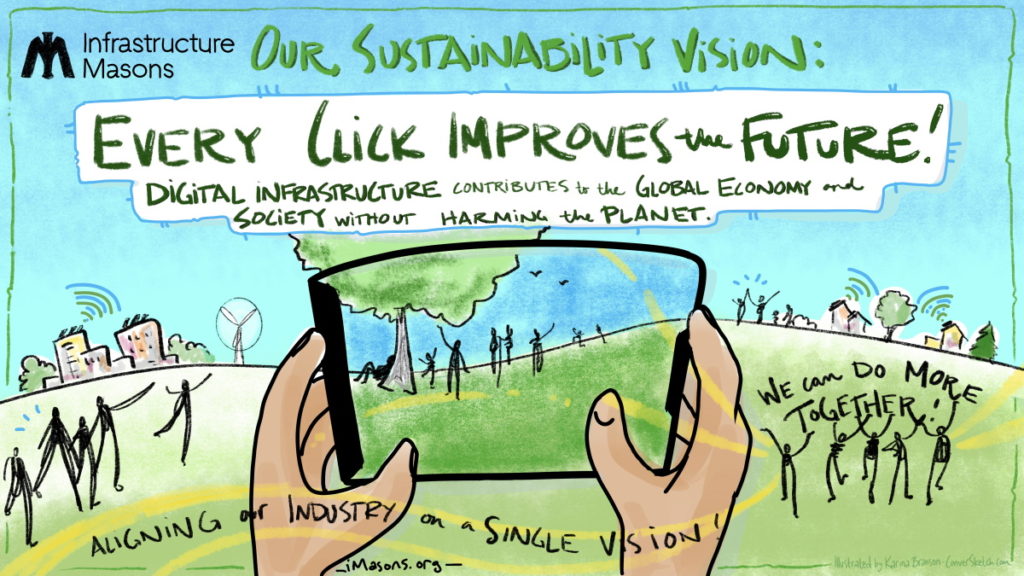
iMasons founder and chairman Dean Nelson introduced the vision: “Every click improves the future.” That means digital infrastructure will contribute to the global economy and society without harming the planet.
Four core values guide decision making relative to the vision. The efforts we choose to pursue shall:
- Reduce emissions, starting with life-cycle carbon emissions.
- Eliminate waste, including energy, heat, water, unused capacity, unneeded redundancy, etc. Reduce, reuse, recycle!
- Be people positive. Increase the quality of life in the communities where we locate.
- Compound our impact. Individuals and companies can do more working together.
“Every click improves the future. Digital infrastructure will contribute to the global economy and society without harming the planet.” Click to tweet
To the question of why Infrastructure Masons is leading the charge on neutralizing the environmental impact of inevitable growth, Summit participants had a quick response: “If not iMasons, then who?” One said, “If anyone can do it, this is the group.” Indeed, iM members are responsible for well over $100 billion of infrastructure projects in 139 countries.
The individuals in the iMasons community and the companies they represent are by and large aligned to our vision. As Kate Brandt, Google Sustainability Officer, explained in her fireside chat with Dean Nelson, “Our vision around sustainability is that we need to put tech into the service of building a more sustainable world. We’ve had tools and partnerships but we also see a huge opportunity for tech we’re all working with like cloud computing, geo mapping, machine learning.”
Noelle Walsh-Elwell, Corporate VP at Microsoft, said in her fireside chat with Dean, “At Microsoft our vision is to inspire every person and organization on the planet to achieve more. It’s not just what you do but how you get there. I aspire to do so safely and sustainably. To leave the planet in as good if not a better place because we do consume considerable power, land, and water.” About the iMasons vision, Walsh-Elwell said, “I like the concept of iMasons and the collective effort it will take to impact the planet as we aspire to.”
Christian Belady, GM of Data Center Services at Microsoft, said in his panel discussion, “For me the vision is all about the long term. For industry leaders there’s a responsibility for [ensuring a safe and sustainable future for our planet]. We owe it to our future. We owe it to humanity. When I interview people, I always ask what’s their definition of sustainability. One response in particular sticks with me: ‘Sustainability is to be around for the long term, and deservedly so.’”
“This is our decisive decade. There is a critical role to play for companies like all of ours.” Click to tweet
5 initiatives for achieving “every click improves the future”
Dean Nelson was joined by Patrik Öhlund and Eddie Schutter to propose initiatives that will deliver the vision. After describing each of the five initiatives – “the programs through which we live our values and make progress on the vision” – Patrik solicited feedback from the 200+ Summit attendees, who participated via the chat function on Zoom.
The collaborative working session was very successful in leveraging the collective brain power of the iM community to tackle our most complex challenge yet.
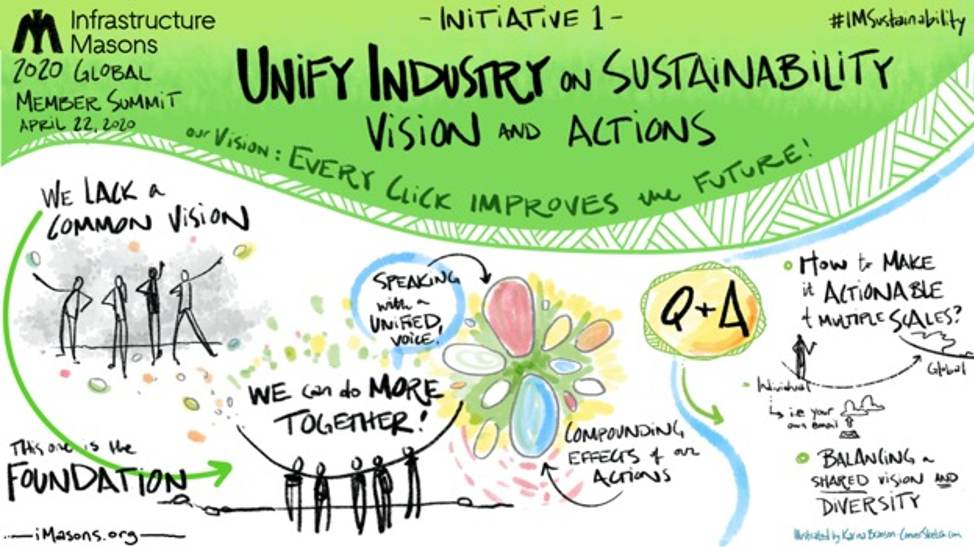
Initiative 1
Unify Industry on Sustainability Vision and Actions
Problem: The digital infrastructure industry lacks a common sustainability vision. We do not speak in one voice to vendors, policy makers, or the public. These mixed messages and uncoordinated actions cause confusion and slow progress.
Initiative description: Establish an industry-wide commitment to a common vision and unified plans, compounding the effect of community actions. (We can do more together.)
Summit conversation highlights:
- “This is critical. The broader industry must work together to develop the goals and to share the data and details – to ultimately improve our condition on a global scale.”
- “Industry-led unification by establishing a governing body with established metrics that can be shared by customers, vendors, and partners.”
- “We have to standardize on how we measure our data so everyone can benchmark against it.”
- “It has to be about more than renewables. It should be inclusive of embodied carbon.”
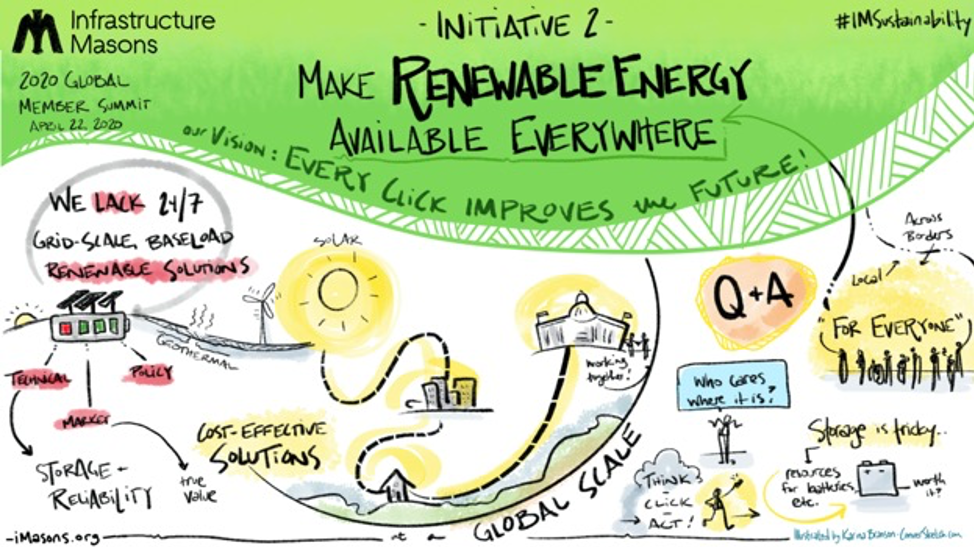
Initiative 2
Make Renewable Energy Available Everywhere
Problem: We lack 24×7 grid-scale base-load renewable energy solutions. Large companies invest independently in renewable energy rather than combining regional demand to provide market visibility enabling investors and regulators to define and implement frameworks, incentives, and solutions to support it.
Initiative description: Work together across the industry and with policy makers to build capacity and enable location-based access to cost-effective renewable energy in all markets globally.
Summit conversation highlights:
- “Frankly I think this needs to change. Make renewable energy available for everyone.” Not everywhere, because “Antarctica doesn’t need renewables.”
- “It’s important to make green and sustainable solutions easier to consume and deploy. It’s a big part of getting people excited to leverage and champion sustainable solutions.”
- “If we show the demand for renewable energy exists at scale across verticals the discussion around cost will dissolve, leading to investments by utility providers to move production to renewables. This is supply and demand at its finest.”
- “The biggest challenge here is governmental policy and entrenched non-renewable businesses. Sustainable power availability has to be an important government relations point for iMasons and the companies members work for.”
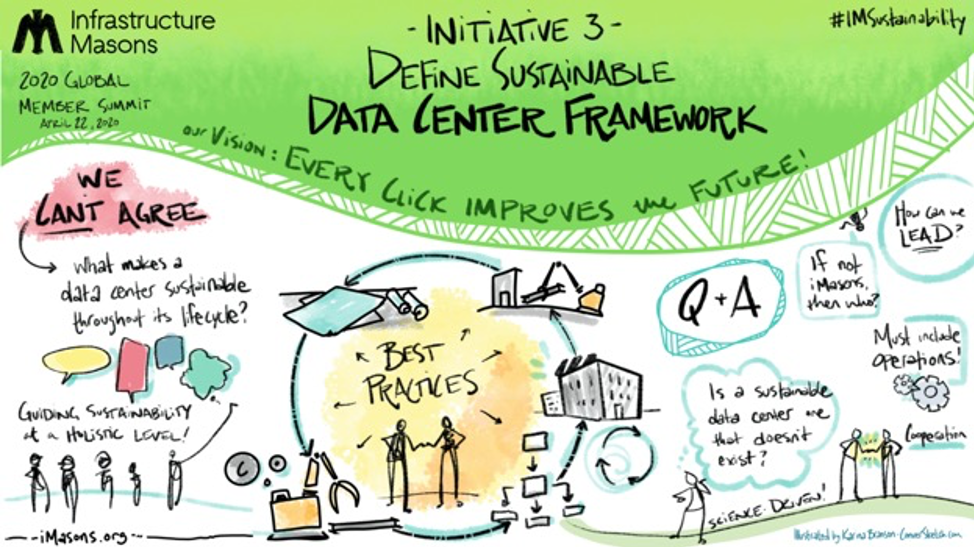
Initiative 3
Define Sustainable Data Center Framework
Problem: We lack a common, industry-wide, end-to-end view of what makes a data center sustainable throughout its life cycle.
Initiative description: Establish an industry best practice framework for the design, build and operation of a full life-cycle aware sustainable data center to help guide owner/operators, providers, supply chain professionals, and policy makers.
Summit conversation highlights:
- “This may be the initiative where iMasons can make the greatest impact. We can publish whitepapers and reference architectures that can become industry standards.”
- “Don’t limit to just the data center. It’s just one element of digital infrastructure.” “Building a sustainable data center with non-sustainable servers is still not optimal. Can we cooperate with OCP, for example?”
- “Expand measurements to include water, land usage/density, carbon footprint, energy efficiency, product life cycle. Reuse/reduce/recycle.”
- “I think metrics are for internal use only. As the PUE guy, I found the public battles for PUE missed the point. The industry average for PUE was as high as 3.0 back in 2000. After PUE came around it became lower than 2. Now it’s closer to 1. So the metric has made companies almost three times as efficient. Who cares whose PUE is lowest as long as the industry is that much better.”
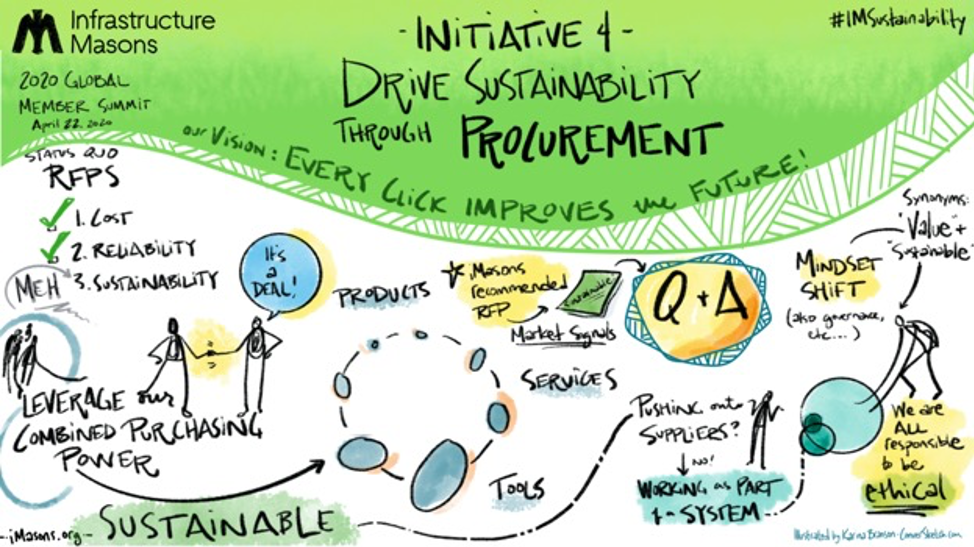
Initiative 4
Drive Sustainability Through Procurement
Problem: RFPs are designed with cost and reliability as priority. Sustainability is secondary. This is counterproductive to designing and implementing sustainable products and solutions.
Initiative description: Leverage our combined purchasing power by aligning procurement specs for high-priority products/services with sustainability values.
Summit conversation highlights:
- “Again, this is a place where iMasons can make a real impact, by publishing examples of RFPs and proposal scoring that includes all the elements of sustainability (environmental, economic, and operational).”
- “At the Department of Energy we are including PUE requirements in cloud contracts and server power supply requirements in server purchases. This should be included in commercial RFPs.”
- “We see this today in specific pursuits/requirements where customers have made sustainability part of their sourcing organizations. It’s a core tenet, not a secondary option.”
- “Procurement is both the carrot and the stick. By requiring vendors to improve their sustainability it works on the overall project impact. This does not absolve the operator from operating the data center in a sustainable fashion.”
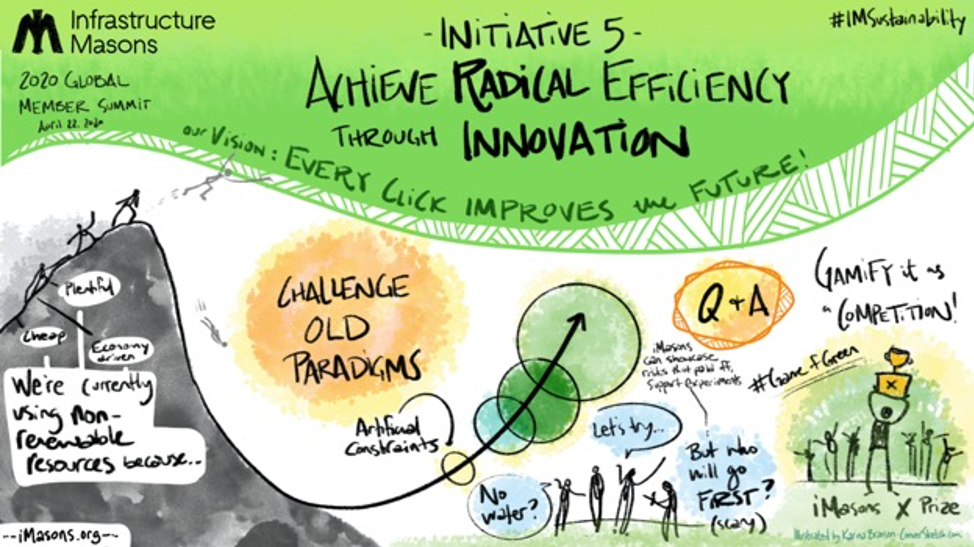
Initiative 5
Achieve Radical Efficiency Through Innovation
Problem: We are using climate impacting resources because they are plentiful and cheap. Innovation is driven by economic constraint not by ecological constraints. The pace of innovation is too slow to reverse climate change. This requires radical new approaches to solve this problem within planetary boundaries.
Initiative description: Challenge old paradigms and inspire smart people, teams and companies to find new and innovative solutions to radically improve end-to-end efficiency by designing under “artificial constraints.” (Imagine there is no additional energy, memory or cycles to use. You must use what you have.)
Summit conversation highlights:
- “It’s too late to reverse climate change. However, we can stop making things worse. I would be happy with just stopping global warming.”
- “Innovation is constrained by fear of introducing risk in mission critical sites. No one wants to be the first! But maybe iMasons can shine some light on those who have tested the waters and succeeded.”
- “An innovation competition would be a great way to get young people involved in the industry.”
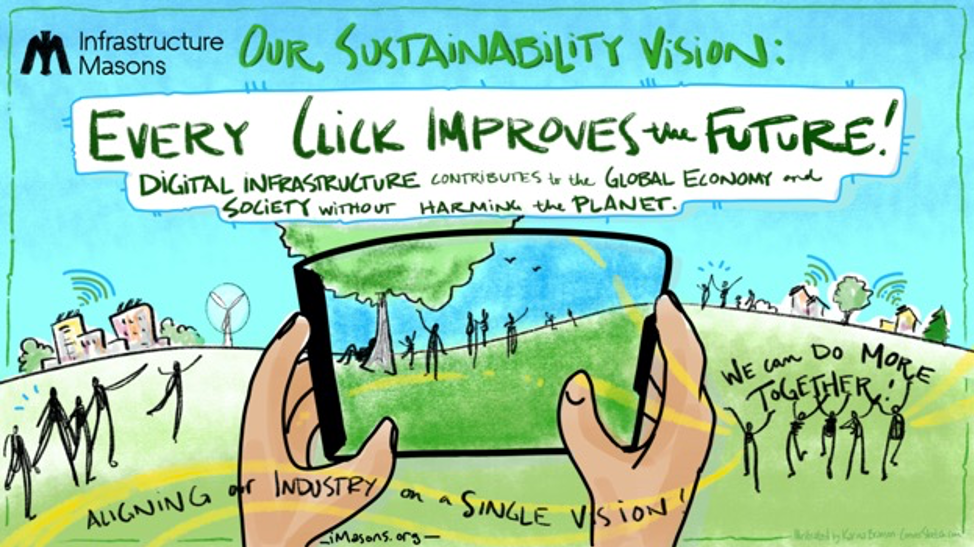
What Have We Missed?
After discussing the five proposed initiatives, Summit attendees were asked to comment on what was missing.
Summit conversation highlights:
- “Make sustainability cool again. Appeal to the upcoming generation of engineers, influencers of the future.
- “How can we expand ‘sustainability’ beyond environmental impacts to include economics, operations, and social impacts?”
- “Continue campaign for increased engagement and consumer education.”
- “How about a program to motivate innovation leaders to share/open source the best practices.” Others had similar comments: “Maybe an initiative around telling stories about what is working” and “Shared success stories and business cases?”
What’s next
To gather input from the growing number of iMasons members around the world, we’re hosting two more virtual summits, in APAC and EMEA. The Global Member Summit APAC – Virtual Event will be held on May 21 and the Global Member Summit EMEA – Virtual Event will be held on May 28.
Each Summit will have a working session like the one described above where participants are asked to provide feedback on our five Sustainability Strategy initiatives. That feedback will be combined with ideas already generated by the Sustainability Committee to develop an Action Plan. That Action Plan will be shared publicly during the Global UN Sustainability Summit in September 2020.
All members are welcome to attend any and all Summits.
If you’re interested in participating – either providing your feedback during an upcoming Summit or as a member of the Sustainability Committee – you can do so via the new iMasons app. (If you don’t yet have the app, learn about it here. It’s free for all members.)
Learn more
Check out our previous post from the Spring 2020 Global Member Summit:
And there’s more to come, so check back soon!
